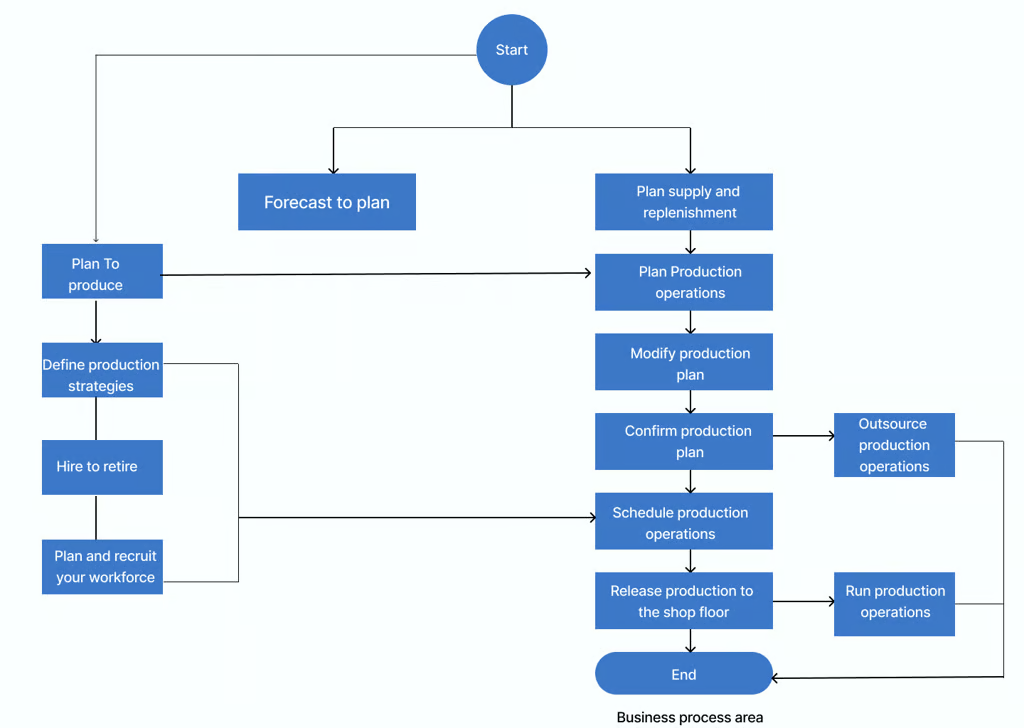In today’s manufacturing world, things are getting more complex. Companies need a solid solution that can help them streamline operations, cut down those extra costs, and boost productivity simultaneously.
Microsoft Dynamics 365 Finance and Operations (D365 F&O) is a powerful solution that can handle almost every part of the manufacturing process, from getting the materials you need all the way to checking quality.
A Forrester study found that manufacturers using Microsoft D365 FO Implementation saw impressive results: a 10% reduction in excess inventory and shrinkage, a 28% increase in employee productivity, a 20% boost in finance team efficiency, and a 6% cut in unnecessary shop floor staffing. Even more striking, workflow improvements drove profits up by 52% in both wholesale and retail operations.
This ERP system brings it all together. Whether it’s planning, scheduling, production, or keeping quality in check, D365 helps make it all work better. It lets you plan production seamlessly, control the shop floor better, manage your inventory more effectively, track costs correctly, and make sure the products are top quality.
Key Features of Microsoft Dynamics 365 Finance and Operations
Production planning and scheduling
Planning production can be tricky, but Microsoft D365 FO implementation makes it feel more manageable. The system kind of helps prioritize what needs to happen first, based on your orders, what’s in stock, and what’s expected. It lets you create production plans, manage your resources, and follow progress, all in one place. You’re less likely to face delays or shortages since it helps you stay ahead and organized.
Instead of getting stuck in complicated spreadsheets, you’ve got tools that show you real-time info so you can adjust schedules quickly. It also gives you a better view of your equipment and workers. You can see when machines aren’t being used, plan maintenance, or match people with the jobs they’re best suited for to keep things running smoothly.

Data collection and analysis
It’s hard to make good decisions without clear data. Microsoft Dynamics 365 Finance and Operations gives you real-time insights into your operations. You can track inventory, see what’s happening on the shop floor, and keep an eye on changing demand, all without waiting for reports.
The system helps spot things slowing you down or costing more than they should, so you can fix them and make improvements. You’ll also be able to look at past data and notice patterns that help you plan better for what’s coming next. Having this info right when you need it means you can make decisions faster and more confidently, instead of guessing or waiting for updates.
Learn More – Microsoft Dynamics AX 12 vs. Dynamics 365 Finance: Why It’s Time to Upgrade
Financial management improvements
Managing finances can get overwhelming, especially when you’re relying on outdated information or gut feeling. Microsoft Dynamics 365 Finance and Operations gives you up-to-date insights so you can see where to cut costs, improve profits, and keep cash flow steady.
It helps you spot chances to grow or areas that might need attention, so you can make decisions earlier before small issues turn bigger. It also keeps you aware of market trends, so your financial plans remain relevant.
Better collaboration across teams
When teams work separately, things slow down. Microsoft Dynamics 365 Finance and Operations connects departments so everyone’s using the same data. Sales, production, procurement, they’re all on the same page.
This makes it easier for production teams to adjust schedules as sales come in. Sales reps can give delivery dates, knowing what’s really in stock. Procurement can plan purchases earlier to avoid delays. With everyone working together, decisions happen faster, and mistakes are reduced since there are no mix-ups between systems.
Create Bills of Materials (BOMs)
A big part of getting production right is knowing exactly what you need for each product. With Microsoft Dynamics 365 Finance and Operations, you can set up Bills of Materials (BOMs) that lay out all the materials, parts, and steps you need to make something. This helps make sure nothing’s missing when it’s time to build.
You can also include subassemblies or any extra raw materials that go into the final product. Once your BOM is set up and approved, you can create and release production orders, keeping everything clear and moving forward. It gives you a better view of your production schedule, so you can follow progress and adjust if anything changes.
Manage quality control
Keeping quality high is super important, and Microsoft Dynamics 365 Finance and Operations makes it easier to stay on top of it. The system lets you set up inspection plans, record test results, and handle reports if something doesn’t meet your standards.
You can define the quality rules you expect and check that everything’s meeting them along the way. If any issues pop up, you’ve got a way to track them and deal with them early, helping avoid bigger problems later. It’s a solid way to keep your products consistent and your customers happy.
Integration Feasibility with External Applications
Microsoft Dynamics 365 Finance and Operations seamlessly integrates with various external applications and systems such as Manufacturing Execution Systems (MES), BAAN, and i2, enhancing overall operational efficiency.
Integration with Manufacturing Execution Systems (MES)
For manufacturers, being on top of production is key. Manufacturing Execution Systems (MES) track every step of the production process, from material usage to work-in-progress status. Integrating SAP MES solutions with D365 F&O means this production data is updated in real-time, so your teams can make decisions based on accurate, up-to-the-minute information. Plus, the integration automates the data transfer, so you don’t have to worry about manual data entry, reducing human error and increasing productivity. This means you can manage everything from production schedules to inventory levels and keep the shop floor flowing.
Integration with BAAN
Many manufacturers still use BAAN for operational management, and it’s great to know Microsoft Dynamics 365 Finance and Operations can integrate with it. By connecting these two systems, you get a single view of your business where operational and financial data work together seamlessly. This means you can transfer data between your operational processes and financial systems with ease and always work with the most up-to-date information. The integration streamlines workflows, aligns financial management with operational goals, and generates more insightful reports so you have a clear view of both the financial and operational health of your business.
Integration with i2
If you use i2’s supply chain solutions, integrating them with Microsoft Dynamics 365 Finance and Operations takes your supply chain to the next level. The combination of both systems allows you to forecast demand, track inventory, and manage suppliers better. By bringing together i2’s predictive analytics and D365 F&O’s real-time data, you can ensure your supply chain activities align with your overall business objectives. This integration means you can optimize inventory levels, reduce lead times, and improve supplier relationships – all of which contribute to a more efficient and responsive supply chain. Whether it’s planning demand or managing procurement, the integrated systems mean you’re always one step ahead.
Learn More – Deploying Intelligent Supply Chain – Why is it Crucial and How does it help the businesses?
Challenges of using Microsoft Dynamics 365 Finance and Operations in manufacturing
One big challenge is just how complex manufacturing can be. You’ve got different plants, suppliers, customers, lots of moving pieces. Trying to bring all of that under one system can feel overwhelming at first. But the good thing is Microsoft D365 FO implementation does give you a way to manage everything from one place. It takes time to set it up right, but once it’s running, it makes processes smoother and helps teams work together better.
Another thing is that manufacturers today need everything to move fast. They need automation, they need to see what’s happening across production and the supply chain at any moment. Dynamics 365 Finance ERP consulting can help with that by giving more visibility and helping standardize things, but getting to that point needs some effort. It’s not a magic fix right away—you’ve got to plan and set it up to see those results.
Data exchange is another tricky part. A lot of manufacturers use a separate manufacturing execution system (MES) along with Microsoft D365 FO implementation. Making sure those two systems talk to each other can be tough without proper integration. But if you set up an integrated solution, the data flows automatically, almost in real-time. Like if you record material to use in the MES, it also shows up in Dynamics 365.
Maximize Efficiency with Microsoft D365 FO Implementation
Microsoft Dynamics 365 Finance and Operations stands as a robust enterprise resource planning (ERP) solution tailored to meet the unique challenges of the manufacturing industry. As the global demand for ERP software rises, companies are seeking ways to boost productivity, lower operational costs, and ensure greater customer satisfaction. The adoption of modern ERP systems like D365 F&O will undoubtedly empower these businesses to achieve sustainable growth and success.
Gain the maximum potential of Microsoft Dynamics 365 and position your company for long-term success by working with a trusted partner like Stridely Solutions. As an experienced Dynamics 365 Finance ERP consulting provider, we help businesses streamline operations, reduce overhead, and improve efficiency across all areas, from bill of material creation to quality control. With our expertise, you’ll be able to outshine competitors and thrive in the fast-paced manufacturing sector. Let’s connect and discuss how we can help.


